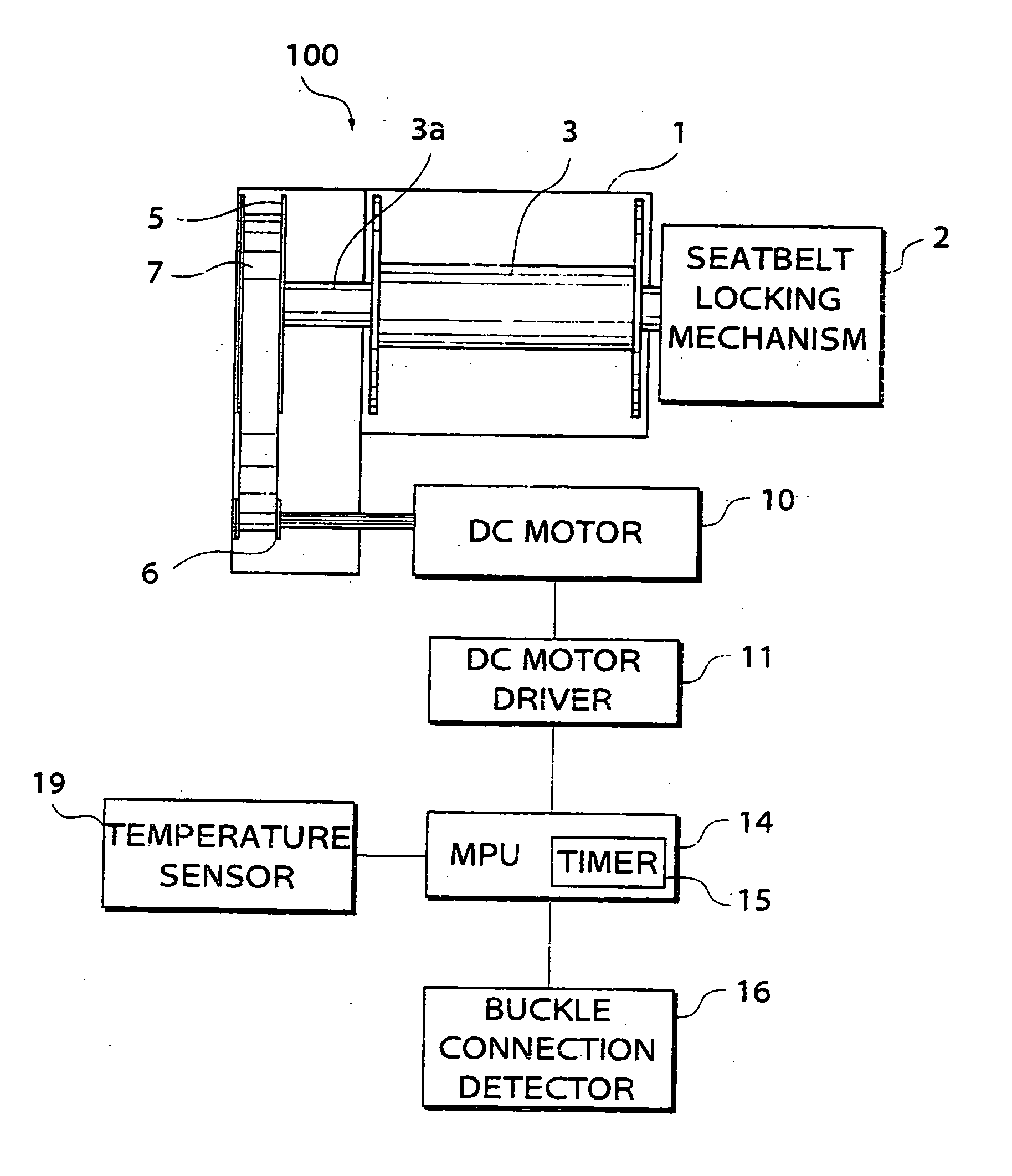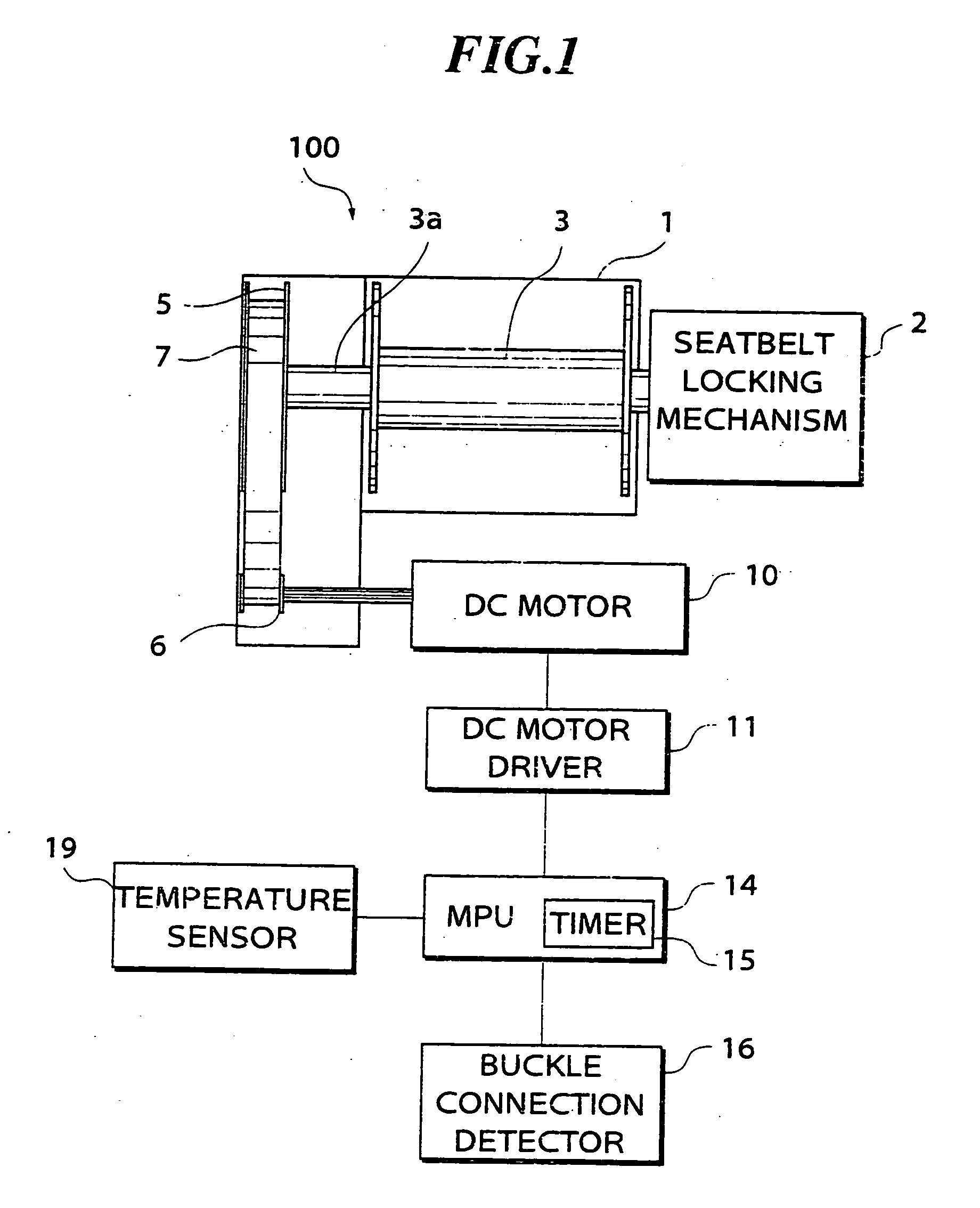Automotive passenger restraint and protection apparatus
a technology for passenger restraints and protection devices, which is applied in the direction of process and machine control, pedestrian/occupant safety arrangements, instruments, etc., can solve the problems of inability to accurately detect faults in dc motors, increase current flowing to motors, and rise in the vicinity of motors, so as to achieve accurate fault diagnosis of apparatuses
- Summary
- Abstract
- Description
- Claims
- Application Information
AI Technical Summary
Benefits of technology
Problems solved by technology
Method used
Image
Examples
first embodiment
Referring first to FIG. 1, there is shown the arrangement of an electric retractor 100 provided in an automotive passenger restraint and protection apparatus according to a first embodiment of the invention.
The seatbelt retractor 100 has a frame 1 in which is rotatably mounted a reel shaft (takeup shaft) 3 for retracting and protracting a seatbelt. Secured to an end of the reel shaft 3 is a known seatbelt locking mechanism 2 which is adapted to lock or stop the seatbelt from being protracted when a predetermined or higher degree of deceleration is applied to an automotive vehicle in which the present apparatus is installed or when the seatbelt is protracted at a predetermined or higher degree of acceleration.
The reel shaft 3 has a central shaft 3a coupled to a central shaft of a reel shaft pulley 5, which is in turn coupled to a DC motor pulley 6 via a power transmission belt 7.
The reel shaft pulley 5 and the DC motor pulley 6 each have an outer periphery thereof formed with ...
second to thirteenth embodiments
of the invention will be described hereinbelow. In the description of these embodiments, elements and parts as well as steps corresponding to those in the first embodiment described above are designated by identical reference numerals, detailed description of which is omitted. In the following, only those which differ from the first embodiment will be described.
second embodiment
An automotive passenger restraint and protection apparatus according to a second embodiment of the invention includes an electric retractor which is identical in construction with the electric retractor 100 of the first embodiment described above, description of which is therefore omitted. The second embodiment is distinguished from the first embodiment only in the manner of fault diagnosis executed by the MPU 14.
A manner of fault diagnosis according to the present embodiment, executed by the MPU 14 will be described hereinbelow.
FIG. 5 is a flowchart showing a fault diagnosis program according to the present embodiment, executed by the MPU 14.
First, the flag FLAG is reset to 0 at a step S501. Then, a signal of a TTL (Transistor Transistor Level) level having a frequency of 10 kHz and a duty factor of 10%, for example is applied to the terminal P1 at a step S502, and the lapse of a predetermined time period (e.g. 1 sec) is waited after the application of the TTL level signal at...
PUM
 Login to View More
Login to View More Abstract
Description
Claims
Application Information
 Login to View More
Login to View More - R&D
- Intellectual Property
- Life Sciences
- Materials
- Tech Scout
- Unparalleled Data Quality
- Higher Quality Content
- 60% Fewer Hallucinations
Browse by: Latest US Patents, China's latest patents, Technical Efficacy Thesaurus, Application Domain, Technology Topic, Popular Technical Reports.
© 2025 PatSnap. All rights reserved.Legal|Privacy policy|Modern Slavery Act Transparency Statement|Sitemap|About US| Contact US: help@patsnap.com



